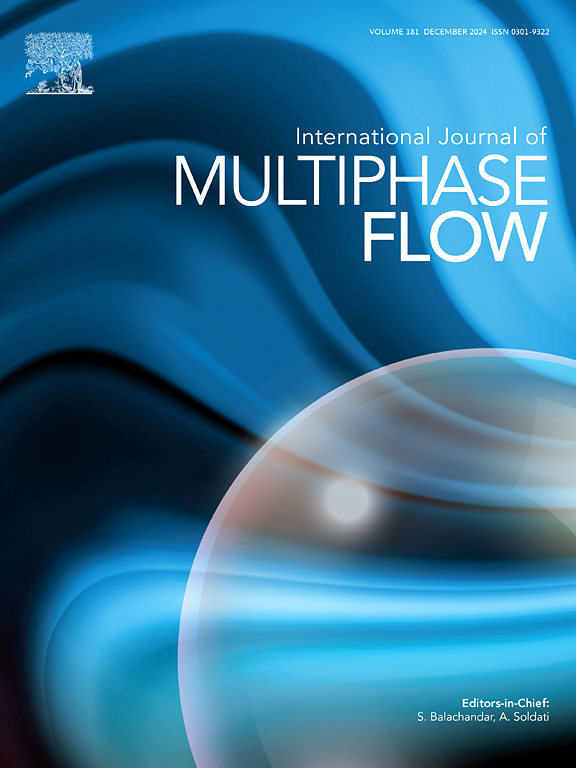Two-phase flow mechanisms in cylindrical heterogeneous-wet capillaries
IF 3.6
2区 工程技术
Q1 MECHANICS
International Journal of Multiphase Flow
Pub Date : 2025-05-02
DOI:10.1016/j.ijmultiphaseflow.2025.105274
引用次数: 0
Abstract
Pore-scale displacement mechanisms govern the flow patterns in heterogeneous-wet porous media. Existing theoretical models built on the polygonal capillaries fail to capture fluid transport across the entire range of wettability parameters due to the limitations in fluid and wettability distributions, posing challenges for accurate prediction of macroscale flow processes. To address this knowledge gap, a novel model of two-phase flow for cylindrical capillaries featuring heterogeneous-wet state is proposed based on the Mayer-Stowe-Princen theory, taking into account the geometric evolution of displacement interfaces. According to the present model, the piston-like displacements driven by main terminal meniscus with dual curvatures, stepwise and mixed displacements controlled alternately by the main terminal and arc menisci are identified. Sensitivity analyses show that a diminished difference in contact angle facilitates the occurrence of piston-like flow, and reduces the influence of oil-wet proportion on capillary entry pressure. Moreover, stepwise displacements are primarily governed by the main terminal meniscus with a single curvature structure, whereas the upward sweep range of arc meniscus is wider during mixed flow involving both drainage and imbibition mechanisms. For stepwise displacement, as oil-wet proportion increases, the sweep range of the main terminal meniscus in oil-wet region expands, and that of the arc meniscus first increases and then decreases, reaching a maximum at an oil-wet proportion of 50 %. Furthermore, nonlinear flow occurs when arc meniscus is close to the capillary surfaces with strong wettability. Compared with the stepwise displacement, the piston-like flow exhibits stronger drainage resistance and imbibition dynamics due to the combined impacts of two wettabilities on the main terminal meniscus. This theoretical model effectively simulates two-phase flow across the full range of wettability parameters, laying the foundation for precise prediction of macroscale flow patterns.

圆柱形非均质湿毛细管中的两相流动机制
孔隙尺度的位移机制控制着非均质湿多孔介质中的流动模式。由于流体和润湿性分布的限制,现有的基于多边形毛细血管的理论模型无法捕捉整个润湿性参数范围内的流体输送,这给宏观尺度流动过程的准确预测带来了挑战。为了解决这一知识缺口,基于Mayer-Stowe-Princen理论,考虑位移界面的几何演化,提出了一种具有非均质湿态的圆柱毛细管两相流模型。根据该模型,识别了双曲率主端半月板驱动的活塞式位移、主端半月板和圆弧半月板交替控制的阶梯位移和混合位移。灵敏度分析表明,接触角差的减小有利于活塞式流动的发生,减小了油湿比对毛细管入口压力的影响。阶阶位移主要受单曲率结构的主端半月板控制,而在排水和吸胀混合流动中,弧半月板向上的扫描范围更大。对于逐级位移,随着油湿比例的增加,主端半月板在油湿区域的扫描范围扩大,弧半月板的扫描范围先增大后减小,在油湿比例为50%时达到最大值。当圆弧半月板靠近具有较强润湿性的毛细表面时,会发生非线性流动。由于两种润湿性对主端半月板的共同影响,与阶梯驱油相比,活塞状流体表现出更强的排水阻力和吸胀动力学。该理论模型有效地模拟了整个润湿性参数范围内的两相流动,为宏观尺度流型的精确预测奠定了基础。
本文章由计算机程序翻译,如有差异,请以英文原文为准。
求助全文
约1分钟内获得全文
求助全文
来源期刊
CiteScore
7.30
自引率
10.50%
发文量
244
审稿时长
4 months
期刊介绍:
The International Journal of Multiphase Flow publishes analytical, numerical and experimental articles of lasting interest. The scope of the journal includes all aspects of mass, momentum and energy exchange phenomena among different phases such as occur in disperse flows, gas–liquid and liquid–liquid flows, flows in porous media, boiling, granular flows and others.
The journal publishes full papers, brief communications and conference announcements.

 求助内容:
求助内容: 应助结果提醒方式:
应助结果提醒方式:


